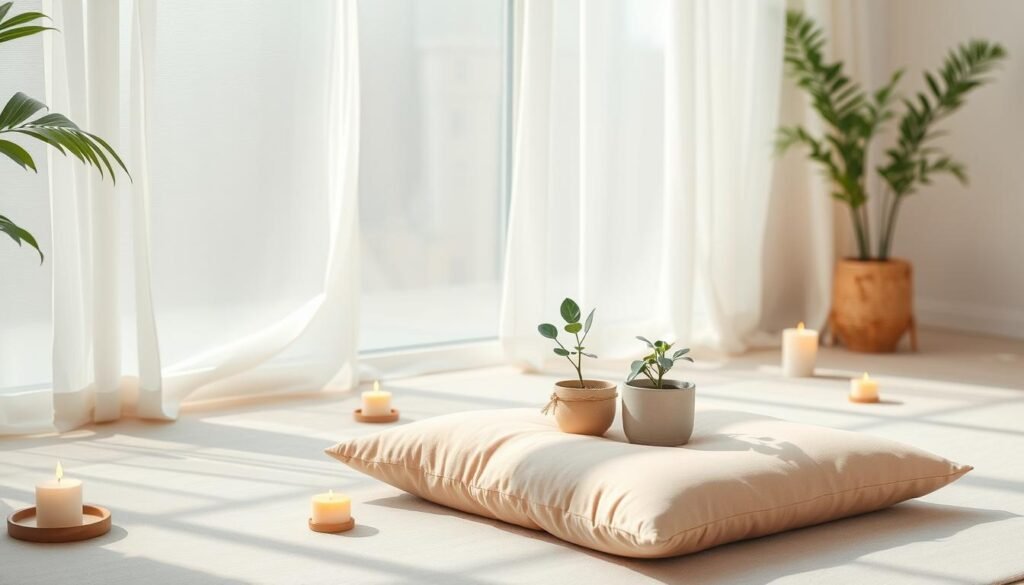Did you know the Muse app has over 300 guided meditations? Each is aimed at different personal and professional aims. This big number shows how popular and varied guided meditation has become. Thanks to technology, finding the perfect meditation is easier. It helps us deal with thoughts and feelings, brings clear thinking, and lowers stress.
Guided meditation offers many benefits, like better mood and more relaxation. Platforms such as Calm, Headspace, and Insight Timer offer many styles and lengths. They fit into busy lives and meet specific needs. This article will dive into the kinds of guided meditations out there. It will show you how to pick one that fits you. If you want to learn more about effective guided sessions, check out this in-depth guide. It talks about different meditation techniques and their benefits.
Key Takeaways
- There are various types of guided meditations to suit different needs.
- Guided meditation can enhance relaxation and emotional well-being.
- Apps like Calm and Headspace provide tailored sessions for beginners and busy individuals.
- In-person meditation classes promote community connection and accountability.
- Guided meditations help people manage anxiety and stress effectively.
Understanding Guided Meditation
Guided meditation is a way for a teacher to lead people in meditation. It helps make meditation easy, especially for beginners. There are many meditation techniques that help improve focus and relaxation.
Common types of guided meditation include Visualization and Body Scan. There’s also Loving-Kindness Meditation and Thematic Meditations. Each one offers different benefits, helping people find what best suits them. This variety helps deepen one’s connection to meditation fundamentals.
Guided meditation has many benefits, like stress relief and better focus. It also improves emotional health. These benefits show meditation is a life-changing practice.
For newbies, the structure of guided meditations is very helpful. It makes beginning meditation less daunting. Through guided practice, people learn how to be more mindful.
Starting with guided meditation means thinking about what you want from it. You should consider what works best for you. Exploring different styles can help find what’s most effective.
There are many resources for guided meditation techniques available. Using these resources can help people learn and grow in meditation.
Benefits of Guided Meditation
Guided meditation is a great way to improve mental health. It helps with stress and many psychological issues. People find they are less stressed after making it part of their day. Research also confirms it lowers anxiety by calming the mind.
It also helps you sleep better. Meditations for sleep get you ready for bed. They create peace, making it easier to fall asleep.
It boosts your focus, too. Through mindfulness, you pay attention better and get more done. This is especially true at work.
You also learn more about yourself. Guided meditation makes you reflect. It helps manage feelings and makes facing problems easier.
- Guided imagery meditation fosters relaxation through visualization techniques.
- Breath awareness meditation guides controlled breathing, invaluable during anxiety spikes.
- These sessions are easy to follow, which aids beginners in developing a meditation routine.
There’s a lot of types of meditation out there. You can find many choices online, including Jason Stephenson’s work. His offerings range from sleep stories to positive affirmations.
Guided meditation is accessible to everyone. There are free trials and lots of online resources. It leads to real improvements in mental health and life satisfaction.
Types of Guided Meditations
There are many types of guided meditations for those who want to relax and clear their mind. Each style offers its own benefits. They match different personal preferences. Knowing about these can help people choose the best one for them.
Mindfulness Meditation
Mindfulness meditation is very popular, especially in the West. It helps you stay in the present and watch your thoughts without judging them. Breath watching and body scanning are part of this practice. It’s great for easing anxiety and stress.
Loving-Kindness Meditation
This type encourages you to feel kindness and compassion for yourself and others. By saying kind phrases, you strengthen your emotional bonds and relationships. Loving-kindness meditation boosts your mental health. It’s good for everyday use.
Yoga Nidra
Yoga Nidra, or yogic sleep, is a mix of guided meditation and deep relaxation. It places you in a state between awake and asleep. This state offers deep rest and renewal. It’s helpful for those dealing with stress, improving emotional balance and mental clarity.
Transcendental Meditation
Transcendental Meditation (TM) is a technique for achieving peace and deep relaxation. You repeat a personal mantra twice a day for 20 minutes. It helps calm your mind. This practice reduces anxiety and boosts well-being. It’s a preferred meditation for many.
Finding the right meditation can greatly benefit your mental health. With many types available, like those mentioned, it’s good to try different styles. This will help you find what works best for you. For more on these meditation styles, check this resource.
Choosing a Guided Meditation Technique
Finding the perfect guided meditation technique is about what you want and like. Some methods are great for feeling relaxed, focusing better, or healing emotionally. For instance, using visualization lets you imagine peaceful places or scenes. This makes relaxation deeper and helps let go of strong emotions.
There’s also focused breathing meditation, good for heart and lung health, noted in a 2017 review. Mantra meditation can be great for beginners. It helps change negative thoughts and increase love for oneself. You can even tailor these mantras to fit your daily life.
Movement can also make meditation better. Walking meditation merges moving with mindfulness. It uses the beauty of nature to uplift and lessen stress. If you like more structure, try Transcendental meditation. It’s done for 15 to 20 minutes twice a day and boosts mental clarity and relaxation.
Below is a comparative overview of various guided meditation techniques:
| Technique | Duration | Benefits | Target Group |
|---|---|---|---|
| Focused Breathing | Varies | Improves heart and respiratory health | Anyone seeking overall well-being |
| Visualization | Varies | Enhances relaxation and emotional release | Individuals seeking calm |
| Mantra Meditation | Varies | Reframes thoughts, increases self-love | Those desiring self-compassion |
| Transcendental Meditation | 15-20 min, 2x/day | Promotes relaxation and focus | Busy individuals |
| Walking Meditation | Varies | Combines movement with nature | Nature lovers and active individuals |
Trying out different guided meditation techniques helps you find what suits you best. Choosing a method that matches your meditation goals can lead to more effective and enjoyable practices.
How to Determine Your Meditation Style
Figuring out your meditation style is key to getting the most out of it. You can look into what you prefer and how you behave to find what best suits you. Knowing the difference between feeling your inner body sensations (interoception) versus noticing things around you (exteroception) helps. For example, if you’re really in tune with your inner feelings, techniques that make you focus on your body might work best.
On the other hand, if you’re more about the outside world, focusing on mindfulness and being aware of your surroundings can bring peace. By thinking deeply about your meditation experiences, you’ll get a clearer picture of what grabs your attention the most.
There are many styles of meditation, like mindfulness, progressive relaxation, and chanting specific phrases. This means there’s a good chance you’ll find one that feels right. For those who love moving around, trying something like yoga or tai chi could be the key.
To help figure out which meditation style suits you, here’s a table summarizing the main features:
| Meditation Style | Description | Best For |
|---|---|---|
| Mindfulness Meditation | Involves awareness of thoughts and surroundings without judgment. | Fostering calmness and reducing stress. |
| Movement Meditation | Combines physical movement with meditative awareness. | Those who prefer an active approach. |
| Progressive Relaxation | Focuses on releasing tension through body awareness techniques. | Individuals wanting to combat anxiety and stress. |
| Mantra Meditation | Utilizes repeated phrases or sounds to achieve mental focus. | Practitioners seeking to deepen concentration. |
| Loving-Kindness Meditation | Encourages feelings of compassion and connection towards others. | Enhancing emotional well-being. |
| Visualization Meditation | Focuses on images and scenes to evoke relaxation and peace. | Individuals aiming for enhanced creativity and calm. |
Knowing about these different types lets you choose the meditation style that fits you best.
Duration and Frequency of Meditation
The duration and frequency of meditation are key to getting the most out of it. Just 13 minutes a day can greatly boost your mood and brain power. Many people find that 7 to 10 minutes work well, especially when starting out. It’s a good place to begin and get into the habit.
As you get more used to it, you might meditate more often. Each session can help you become more mindful. How often you meditate depends on what you want, your schedule, and your lifestyle.
Experts say that how well you meditate matters more than how long. Making it a daily habit is important for seeing benefits. Leah Santa-Cruz from Balance says it’s more about how regularly you do it, not how long you sit.
You can try out different meditation styles to see what suits you best. Mixing it up can make you happier and give better results. Meditation is all about what helps you the most. For more on how long to meditate, visit this helpful page.

Popular Guided Meditation Styles
Many people look for ways to make their meditation practice better. Movement-Based Meditation and Chakra Meditation are top choices. They are special because they help build awareness and emotional balance.
Movement-Based Meditation
Movement-Based Meditation mixes exercise with being mindful. Tai Chi and Qigong use smooth moves that match your breathing. This blend helps you become more aware and relaxes you. People find it great for getting rid of stress and feeling better overall. To learn about different styles, check out guided meditations.
Chakra Meditation
Chakra Meditation works on the body’s energy spots. It gives insights into how we feel both emotionally and physically. By balancing these energies, the practice increases self-awareness and well-being. Those who try it often feel emotionally stronger. It’s a great choice to add to your meditation habits.
| Meditation Style | Focus | Benefits |
|---|---|---|
| Movement-Based Meditation | Physical & Mindful Movement | Enhances awareness, reduces stress |
| Chakra Meditation | Energy Centers & Balance | Improves emotional well-being, fosters resilience |
Trying out these guided meditation styles can help you know your mind and emotions better. Each style brings its own benefits, improving how you feel in daily life.
Meditation Apps for Guided Sessions
People are increasingly turning to meditation apps to improve their well-being. There are plenty of options out there, each offering something unique. Apps like Calm, Headspace, and Insight Timer are at the forefront. They offer a wide range of guided practices. These apps allow users to personalize their experience. They can pick from different themes and session lengths.
Expert guidance makes meditation easier for users. For instance, Headspace offers a Basics curriculum. It’s good for all experience levels. There are three levels for beginners and eight for advanced users, with ten sessions each. There’s also content specifically for kids, grouped by age.
Happier is great for those just starting out, with over 50 meditations titled “Great for Beginners.” It also provides a 7-day free trial. Calm offers various subscription options, starting with a 7-day trial. Insight Timer boasts over 150,000 free meditations. Plus, there are premium subscriptions for more content.
These apps also boost motivation through community challenges and rewards like badges. This helps users stay focused on their meditation goals. The array of meditation apps helps users achieve better mental clarity and emotional balance.
| App Name | Free Trial | Annual Cost | Features |
|---|---|---|---|
| Headspace | Yes | $69.99 | Over 70 million downloads, tailored sessions for kids, allows offline access |
| Calm | Yes | $69.99 | Variety of meditations, sleep stories, and calming music |
| Happier | 7-day Free Trial | $99 | Over 50 beginner meditations, community engagement features |
| Insight Timer | No | $59.99 (premium) | 150,000+ free meditations, vast content library |

Finding a Qualified Meditation Teacher
Finding the right meditation teacher can really help your journey. A good instructor doesn’t just teach techniques. They offer personalized advice to meet your needs. This can take your meditation practice to a new level, making it more effective and life-changing.
There are many ways to find a great meditation teacher. You can find them at local centers or by looking online. Community classes and workshops are great too. Learning from experts deepens your understanding of meditation. It adds to your own practice.
Different teaching levels exist to suit everyone’s needs. Fellowship is about growing in meditation as a community. Mentorship offers personal advice in smaller groups. Transmission teaches through shared experience, not just instructions.
Having ongoing support is key. Programs like Mindfulness-Based Stress Reduction (MBSR) connect you with teachers and peers. This helps build a learning community. Many recommend getting a dedicated teacher. They stress the importance of personalized attention for mastering meditation.
Below is a table that summarizes several notable meditation instructors to consider:
| Name | Background/Style | Notable Contributions |
|---|---|---|
| Elena Brower | Vinyasa Yoga | Renowned author and teacher focusing on mindfulness and self-compassion |
| Jack Kornfield | Insight Meditation | Co-founder of the Insight Meditation Society, author of several influential books |
| Tara Brach | Mindfulness and Compassion | Famous for integrating Western psychology into mindfulness teachings |
| Angel Kyodo Williams | Zen Buddhism | An advocate for social justice, emphasizing the connection between mindfulness and activism |
| Joseph Goldstein | Insight Meditation | One of the first Americans to study meditation in India, co-founder of the Insight Meditation Society |
As meditation gains popularity, the need for qualified instructors gets higher. Working with skilled teachers ensures proper learning. You’ll get the support needed to do well in mindfulness. For those mixing physical activity with mindfulness, there are resources. They help you blend these practices into your life, boosting mental health and well-being.
How to Start Your Meditation Practice
Beginning your meditation journey can truly change your life. It’s key for newbies to find a quiet, comfy spot without any distractions. This peaceful setting helps maintain focus and encourages relaxation, making it easier to dive into the practice.

It’s important to set clear goals when starting. You might want to meditate for stress relief or better concentration. Making it a daily habit shows your dedication, which enriches your day.
Start with short, 5-minute sessions. As you get more comfortable, you can slowly extend your meditation time. Studies show that meditating for just 12 minutes a day can boost happiness and lower anxiety. Keeping a journal of your journey helps increase mindfulness and keeps you committed.
| Experience Level | Recommended Session Duration | Meditation Frequency |
|---|---|---|
| Beginners | 5-10 minutes | Daily |
| Intermediate | 10-20 minutes | 4-5 times a week |
| Advanced | 20-30 minutes | 5-7 times a week |
As you get used to meditating, you’ll see many benefits. Your focus will improve, and you’ll handle emotions better. Regular meditation also boosts your immune system. Staying committed to meditation can dramatically change your life. It teaches the importance of self-care and helps in personal development. With time, meditation becomes a key part of living a mindful, balanced life.
Conclusion
Finding the right guided meditation is a personal journey. It differs greatly from one person to another. There are many techniques available, like mindfulness and transcendental meditation. These allow people to find what best fits their needs and preferences.
Each meditation method has unique benefits. This helps practitioners discover what works best for them. This way, everyone can find a method that resonates with them.
Many studies show the benefits of guided meditation on mental health. A study in 2014 showed that practicing transcendental meditation reduced stress and burnout. Another study in 2022 found that mantra-based meditation lessened anxiety and depression.
These studies highlight how regular meditation can improve focus and emotional control. Many people notice these benefits right after their meditation sessions.
With consistent meditation, individuals can improve self-awareness and manage their emotions better. They also work towards greater well-being. There’s a wide variety of guided meditations out there, ensuring everyone can find one that suits them.
Taking time to explore different meditations is a key step in one’s self-improvement journey. It can be a life-changing experience. It helps individuals achieve a deeper sense of fulfillment.